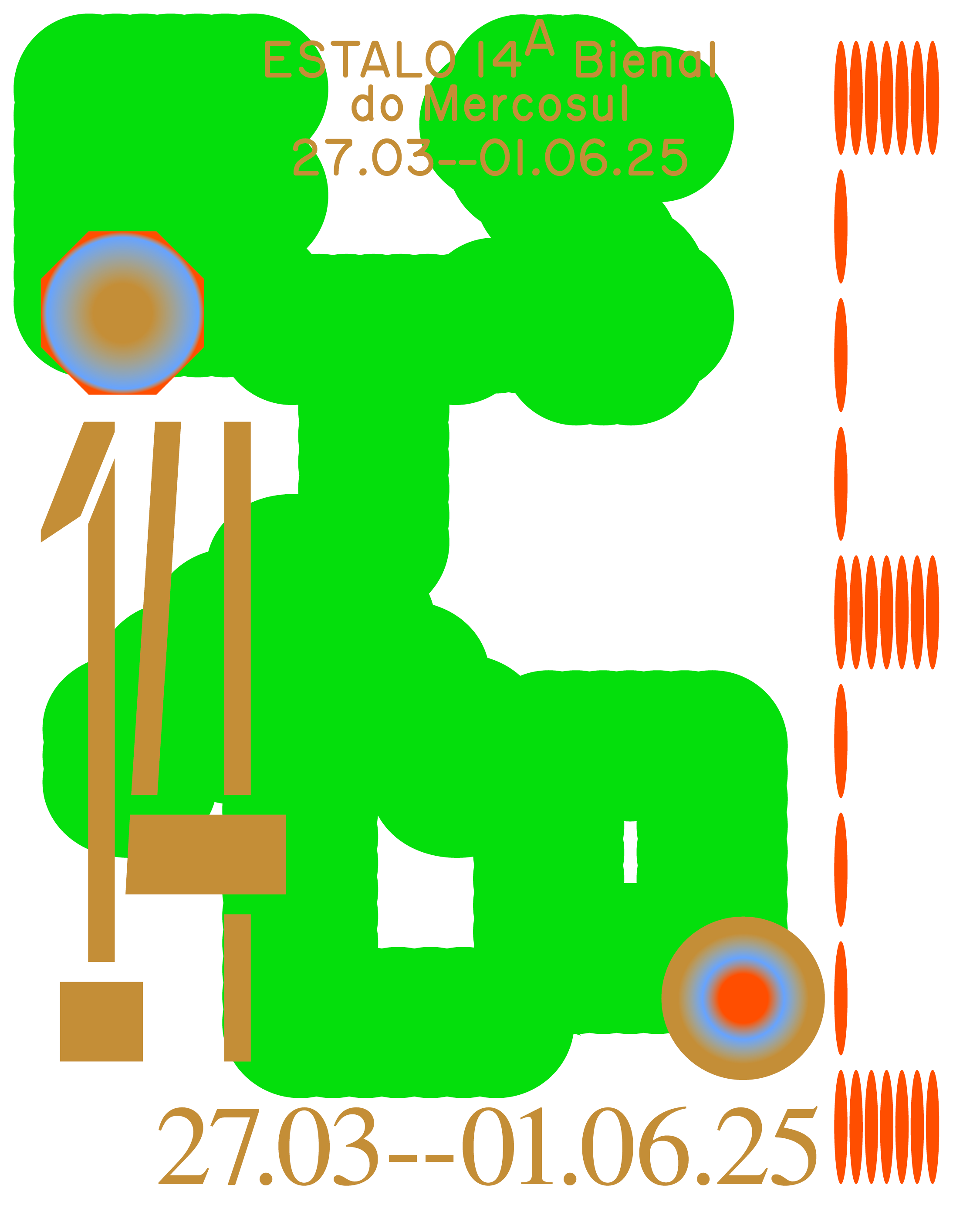IBA – Guiding Principles
18 November 2024Walk&Talk Bienal de Artes Announces Dates and Title!
24 November 2024
Bienal do Mercosul
14th Edition | 27 March / 1 June 2025
Porto Alegre, Rio Grande do Sul
With Raphael Fonseca as chief curator, the 14th edition of the Mercosul Biennial will last two months in the capital of Rio Grande do Sul, featuring 76 artists from different geographies and an intense cultural and educational program.
The Mercosul Biennial Foundation announced this Tuesday, the 19th, the list of artists and cultural spaces that will host the exhibition next year. With the idea of “Estalo” (“Snap”) as its central concept, the exhibition is scheduled to open on March 27, 2025, and will be spread across 18 different spaces in Porto Alegre, some of which are new to the Biennial program.
The main objective of the exhibition’s curatorial concept is to deal with the notion of
transformation. In the blink of an eye and in a brief fragment of time, our bodies and nature, for example, undergo transformations of varying magnitudes. From the metamorphoses that silently emerge in our organisms to sudden and noisy movements – living is synonymous with never being in a stable and safe place. For 66 days, the biennial will spread throughout the city, bringing together works by 76 artists from different regions of the world, believing in exchanges between different social contexts and artistic languages to approach the diversity of experiences between art and life.
Over two years of work, the artistic team led by chief curator Raphael Fonseca, in addition to adjunct curators Tiago Sant’Ana and Yina Jimenez Suriel and assistant curator Fernanda Medeiros, designed a program of exhibitions and activities that bring to the city of Porto Alegre a great diversity of works, interests and world views suggested by the artists gathered. These artistic projects reflect their geographic and cultural contexts in a field ranging from an interest in abstraction to more documentary projects. This zigzag of different artistic poetics interests this edition of the Biennial.
The 14th Mercosul Biennial aims to reach a larger and more diverse audience – investing in bringing art closer to local and global audiences. This fact is also evident in the list of artists, which has a considerable presence of representatives from Latin America and Asia. Of the 76 artists that make up the exhibition, around 65% are international artists, and most of the works are commissioned.
In addition to being present in institutions that have been a regular part of the Biennial’s history, such as Farol Santander, the Museu de Arte do Rio Grande do Sul (MARGS), and Usina do Gasômetro, this edition is characterized by being present in other regions of the city, such as the Lomba do Pinheiro and Restinga neighborhoods, in the Estação Cidadania units, and also, for the first time, at Cinemateca Capitólio, Pop Center, Museu do Hip Hop and Fundação Vera Chaves Barcellos, in Viamão. In this way, the event is believed to expand and form a new audience in the Greater Porto Alegre region.
Raphael Fonseca reiterates the Biennial’s vocation to establish connections with different geographies: “Porto Alegre and the state of Rio Grande do Sul are multicultural spaces with many layers of cultural and historical complexity. It is fair that an edition of the Mercosul Biennial can also, within the limits of any major event dedicated to the visual arts, reflect this diversity and contribute to a greater knowledge of such interesting artists by a broad audience,” says the chief curator.
Education, Public Programs, and Publications
In addition to its exhibition dimension, the Mercosul Biennial stands out for its educational curation, which aims to bring the main exhibition closer to diverse audiences. The educational program will unfold in activities such as seminars, discussion groups, training courses for teachers and mediators, and the production of educational material that will include texts and images by educators and researchers. With this, the Biennial aims to be a space not only for aesthetic enjoyment but also for training and meaningful exchanges. The educational curation, signed by Andréa Hygino and Michele Zgiet, is based on concepts such as the wheel and the “gira” (“spin”) as practices of community formation. These strategies form the backbone of a project that establishes the Biennial as a time space for learning and reflection, radiating knowledge in the field of art education while expanding a more in-depth and accessible art experience for all audiences.
Another new feature of the 14th Mercosul Biennial is the curation of Public Programs by Anna Mattos and Marina Feldens. Activities will activate different cultural centers, museums, and public spaces in Porto Alegre through lectures, events, film screenings, parties, field trips, workshops, and more. The objective of the Biennial’s Public Programs is to make the show resonate beyond the exhibitions, proposing a constant “biennial state” whose construction takes place through the experience of the public.
In addition to these activities, the 14th Mercosul Biennial is organizing two publications conceived from a perspective transversal to the curatorial proposal. The first of these will be launched at the exhibition’s opening, and the aim is to bring reflections that relate to the conceptual approaches of the 14th Biennial to the conversation, paying particular attention to discussions about the perceptive system of the human species. It will consist of essays and literary texts commissioned by authors such as the writer José Falero from Rio Grande do Sul, the neuroscientist Andrea Gomez, the quantum computer scientist Iordanis Kerenidis, the writer Karim Kattan and the artist and DJ Hannah Katherine Jones. The catalog is the second publication, to be released at the end of the Biennial. Conceived as a visual essay, this publication will be not only a memory of the exhibition project, educational program, and public programs but also a record of the evolution of the discussions that accompanied its conception. The publications are free. Both will also be available in digital format on the Mercosul Biennial website.
The visual identity of this edition was created by Estúdio Margem, based in São Paulo. Using colors present in the spectrum of light refraction and a mix of fonts from different periods in the history of typography, the Studio proposes an immersion in vibrant and saturated colors that give a freshness to the Biennial’s brand. Meanwhile, the Biennale’s architectural thinking and exhibition design are signed by Juliana Godoy, who continues her interest in suggesting a spatial unity and visual narrative even with a project of this magnitude that deals with spaces so different from each other.
Institution
After the Mercosul Biennial was postponed due to the climate disasters that hit Rio Grande do Sul in 2024, the challenges for the exhibition have intensified. The Mercosul Biennial Foundation reiterates its desire to continue carrying out work with social impact, which is fundamental to the cultural revitalization of RS, as reinforced by President Carmen Ferrão: “We have the mission of placing the Mercosul Biennial in the spotlight of international contemporary art. Among so many challenges and achievements, in October, the Biennial became a member of the International Biennial Association (IBA), and we continue to believe that the formative and transformative reach of our disruptive projects strengthens everything.”
The 14th Mercosul Biennial is made possible by the Federal and State Laws of Incentive to Culture, master sponsorship from Santander and Banrisul, and premium support from Renner and Blue Ville. It is an event organized by the Mercosul Biennial Foundation, the Ministry of Culture, and the Federal Government, with funding from the Pró-Cultura system of the Secretariat of Culture of the Government of the State of RS.
Created in 1996, the Mercosul Visual Arts Biennial Foundation is an institution whose mission is to develop cultural and educational projects in visual arts, adopting the best management practices and fostering dialogue between contemporary artistic proposals and the community. Recognized as the largest group of events dedicated to contemporary Latin American art worldwide, it provides thousands of people with free access to culture and art.
Venues where the 14th Mercosul Biennial will take place
Cinemateca Capitólio
Casa de Cultura Mário Quintana
Espaço Força e Luz
Estação Cidadania Lomba do Pinheiro
Estação Cidadania Restinga
Farol Santander
Fundação Ecarta
Fundação Iberê Camargo
Fundação Vera Chaves Barcellos
Goethe-Institut Porto Alegre
Instituto Ling
Museu de Arte Contemporânea do Rio Grande do Sul – MAC-RS
Museu de Arte do Rio Grande do Sul – MARGS
Museu do Hip Hop
Museu do Trabalho
Pop Center
Usina do Gasômetro
Vila Flores
List of artists at the 14th Mercosul Biennial
(All artists with asterisks are doing commissioned work for the biennial)
Ad Minoliti (Argentina, 1980)*
Alanis Obomsawin (Abenaki/Canada, 1932)
Ali Eyal (Iraq, 1994)*
Amol K. Patil (India, 1987)*
Awilda Sterling-Duprey (Puerto Rico, 1947)*
Berenice Olmedo (Mexico, 1987)*
biarritzzz (Brazil, 1994)*
Bonikta (Brazil, 1996)*
Chico Machado (Brazil, 1964)*
Christine Sun Kim (United States, 1980)*
Claudia Alarcón (Wichi/Argentina, 1989)*
Claudio Goulart (Brazil, 1954-2005)
Cornelius Andrew (England, 1936-1981)
Damián Ayma Zepita (Aymara/Bolivia, 1921-1999)
Darks Miranda (Brazil, 1985)*
Diedrick Brackens (United States, 1989)
Djalma do Alegrete (Brazil, 1931-1994)
Eduardo Montelli (Brazil, 1989)*
Emilija Škarnulytė (Lithuania, 1987)
Erick Peres (Brazil, 1994)*
Farah Al Qasimi (United Arab Emirates, 1991)
Fatima Rodrigo (Peru, 1987)*
Felipe Rezende (Brazil, 1994)*
Felipe Veeck (Brazil, 1996)*
Firas Shehadeh (Palestine, 1988)*
Freddy Mamani (Aymara/Bolivia, 1971)
Froiid (Brazil, 1986)*
Fyerool Darma (Singapure, 1987)*
Heitor dos Prazeres (Brazil, 1898-1966)
Gabriel Chaile (Argentina, 1985)*
Gretchen Bender (United States, 1951-2004)
Iberê Camargo (Brazil, 1914-1994)
Ismael Monticelli (Brazil, 1987)*
Jacolby Satterwhite (United States, 1986)
José Ballivián (Bolivia, 1975)*
Julia Isídrez (Paraguay, 1967)*
Kira Xonorika (Guarani/Paraguay, 1995)*
Laryssa Machada (Brazil, 1993)
Letícia Lopes (Brazil, 1988)*
Li Yi-Fan (Taiwan, 1989)
Li Yong Xiang (China, 1991)*
Lorenzo Beust (Brazil, 1997)*
Marcus Deusdedit (Brazil, 1997)*
Marina Rheingantz (Brazil, 1983)
Mauro Fuke (Brazil, 1961)*
Maya Weishof (Brazil, 1993)*
Minia Biabiany (Guadalupe, 1988)*
Nam June Paik (South Korea, 1932-2006)
Natasha Tontey (Indonesia, 1989)
Nereyda López (Cocama/Tikuna/Peru, 1965)
New Red Order (Ojibway e Tlingit/United States, 2016)
Nicole L’Huillier (Chile, 1988)*
Nikita Gale (United States, 1983)
Ogwa (Ishir/Paraguay, 1937-2008)
Özgür Kar (Turkey, 1992)
Paul Mpagi Sepuya (United States, 1982)
Randolpho Lamonier (Brazil, 1988)*
Retratistas do Morro/Afonso Pimenta (Brazil, 1954)*
Rochelle Costi (Brazil, 1961-2022)
Rodrigo Cass (Brazil, 1983)*
Samson Young (Hong Kong, 1979)
Sandra Vásquez de La Horra (Chile, 1967)*
Santiago Yahuarcani (Cocama/Uitoto/Peru, 1960)
Sara Modiano (Colombia, 1951-2010)
Taiki Sakpisit (Thailand, 1975)
Tang Han (China, 1989)*
Tirzo Martha (Curaçao, 1965)*
Ulises Beisso (Uruguay, 1958-1996)
Urmeer (Mexico, 1991)*
Valerie Brathwaite (Trinidad & Tobago, 1940)*
Venuca Evanán (Peru, 1987)*
Vitória Cribb (Brazil, 1996)*
William Gutiérrez (Colombia, 1959)*
Wiki Pirela (Venezuela, 1992)*
Yunchul Kim (South Korea, 1970)
Zé Carlos Garcia (Brazil, 1973)*



